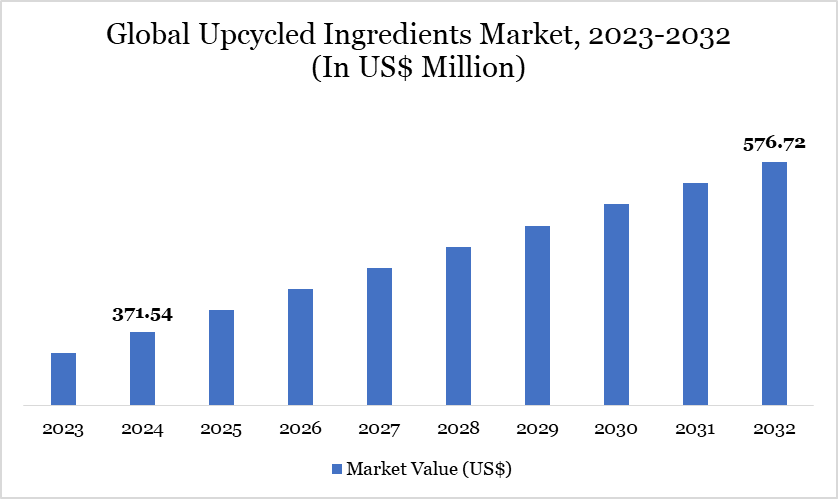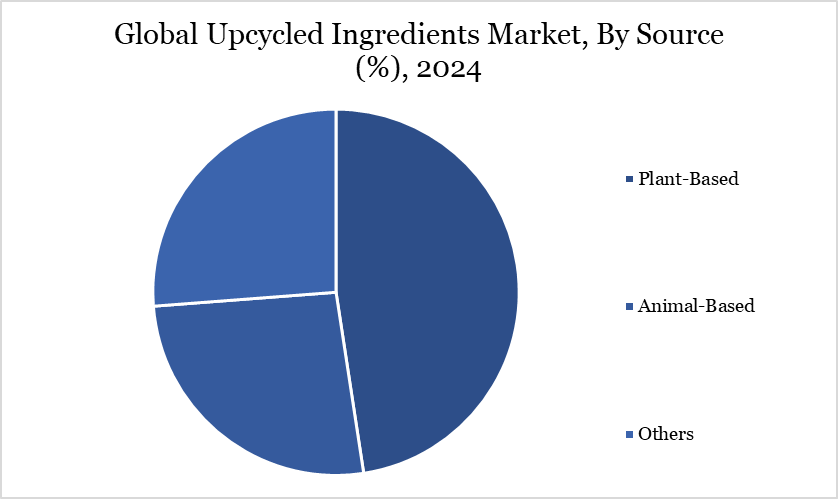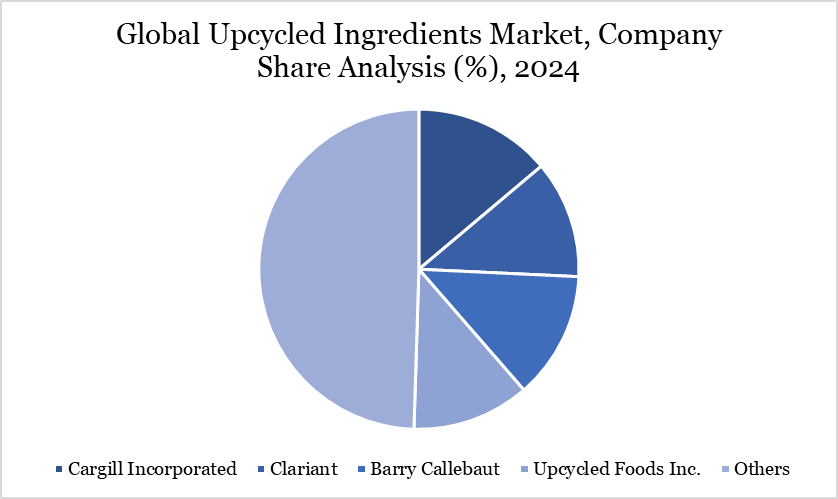Upcycled Ingredients Market Size
Upcycled Ingredients Market reached US$ 371.54 million in 2024 and is expected to reach US$ 576.72 million by 2032, growing with a CAGR of 5.65% during the forecast period 2025-2032.
The global upcycled ingredients market is gaining momentum as a key solution to the escalating challenges of food waste and environmental sustainability. According to a recent report by the UN Environment Program (UNEP), municipal waste is projected to increase by two-thirds, with associated costs nearly doubling within a generation. This underscores the urgent need for innovative approaches to reduce waste and promote circular economies. Upcycling has emerged as a critical strategy in this effort.
Driven by growing consumer demand for sustainability, advances in food technology and increasing regulatory support, the upcycled ingredients market is expanding rapidly. By repurposing surplus fruits, vegetables, grains and legumes, upcycled ingredients are transforming into a variety of products, from snacks and beverages to nutritional supplements and animal feed. This market offers a promising solution to reduce food waste, conserve resources and meet the rising demand for eco-friendly, value-added food products.
Upcycled Ingredients Market Trend
Government support is emerging as a key trend in the upcycled ingredients market through policies that promote circular economy practices. Many governments are introducing incentives, grants, and tax benefits for companies that repurpose food and agricultural waste. Regulatory frameworks are being updated to allow and encourage the safe use of upcycled materials in food and cosmetics.
For instance, in June 2024, the USDA, EPA, FDA, and the White House unveiled the National Strategy for Reducing Food Loss and Waste, aiming to cut food waste by 50% by 2030. This initiative, central to President Biden’s climate agenda, tackles food waste’s role in methane emissions while promoting a circular economy. It also supports the growing US$ 46 billion market for upcycled ingredients, positioning US as a global leader in sustainable food systems and organic waste recycling.

For more details on this report – Request for Sample
Market Scope
Metrics | Details |
By Type | Upcycled Proteins, Upcycled Fibers, Upcycled Oils and Fats, Upcycled Flours, Upcycled Sweeteners, Others |
By Source | Plant-Based, Animal-Based, Others |
By Processing Technology | Fermentation, Pulsed Electric Field (PEF) Assisted Extraction, Pressurized Liquid Extraction (PLE), Supercritical Fluid Extraction (SFE), Membrane-Based Separation, Spray Drying Technology, Others |
By Form | Powders, Liquids, Flakes/Granules, Oils/Fats, Others |
By End-User | Food & Beverages, Cosmetics and Personal Care, Nutraceuticals, Animal Feed and Pet Food, Others |
By Region | North America, South America, Europe, Asia-Pacific, Middle East and Africa |
Report Insights Covered | Competitive Landscape Analysis, Company Profile Analysis, Market Size, Share, Growth |
Upcycled Ingredients Market Dynamics
Role of Upcycled Ingredients in Addressing the Global Waste Crisis
The growing global waste crisis, as outlined in the Global Waste Management Outlook 2024 by UNEP, is driving the need for more sustainable solutions to manage the increasing volume of waste, projected to rise from 2.1 billion tons in 2023 to 3.8 billion tons by 2050. The direct cost of waste management in 2020 was US$ 252 billion, but when factoring in hidden costs from pollution, health impacts and climate change, this figure rose to US$ 361 billion.
The projections reach US$ 640.3 billion by 2050 without significant action. This rising cost underscores the urgency for more sustainable practices, including those found in the global upcycled ingredients market. Upcycled ingredients, derived from food surplus, by-products, or waste materials, directly address the need for waste reduction by converting discarded resources into valuable products, thus lowering the environmental burden of waste disposal.
The circular economy model, promoted by UNEP, offers a potential solution that can not only limit waste management costs to US$ 270.2 billion by 2050 but also generate a net gain of US$ 108.5 billion annually. Upcycled ingredients fit seamlessly into this model by promoting waste avoidance, sustainable practices and resource efficiency. As consumers and industries increasingly demand sustainable solutions, the upcycled ingredients market is growing rapidly.
Lack of Consumer Awareness
Lack of consumer awareness and understanding of the benefits and quality of upcycled products hinders market growth. Many consumers remain unfamiliar with upcycled ingredients and there is a prevalent perception that these products may be of lower quality or unsafe due to their origins in food waste or by-products. Negative consumer perceptions can limit market growth and affect trust in upcycled food products, even when the ingredients are safe and high quality.
The negative perception can create hesitancy, limiting demand and slowing market adoption, particularly in retail food and beverage segments where consumers are cautious about the source and safety of their purchases. Despite growing sustainability trends, the limited awareness of the environmental and nutritional benefits of upcycled ingredients hinders their widespread acceptance, preventing the market from reaching a broader audience and stalling growth potential.
Upcycled Ingredients Market Segment Analysis
The global upcycled ingredients market is segmented based on type, source, processing technology, form, end-user and region.

Plant-Based Sources Dominate Global Upcycled Ingredient Market Due to Abundant Availability and High Nutritional Value
The plant-based segment plays a dominating role in the global upcycled ingredients market by driving both its growth and innovation. The market taps into the growing demand for plant-based foods, where a vegan population of 88 million vegans in the world, according to the World Animal Foundation, aligns with trends focused on sustainability, waste reduction, and cleaner labels.
As consumers increasingly seek sustainable, eco-friendly food options, upcycled plant-based ingredients provide an ideal solution. The plant-based ingredients, derived from surplus or discarded plant materials (such as fruit peels, stems or grains), are gaining traction for their ability to reduce food waste while offering nutritional benefits. As the global shift towards plant-based diets intensifies, the demand for upcycled plant-based ingredients continues to grow.
Upcycled Ingredients Market Geographical Share
Demand for Sustainable Products in North America
North America dominates the upcycled ingredients market due to growing consumer demand for sustainable products, strong industry infrastructure and innovation. The US is responsible for over 12% of global waste, despite representing just 4% of the world’s population, as reported by Environment America. Nearly 60 million tons of food 30-40% of the US food supply are discarded annually, equating to 325 pounds per person, according to the USDA and Recycle Track Systems.
The massive waste problem presents a significant opportunity for upcycled ingredients, as companies like ReGrained and Toast Ale repurpose surplus food, such as spent grains and unsold bread, into valuable products. Corporate giants like PepsiCo and Nestlé are increasingly incorporating upcycled ingredients into their products, supporting their sustainability goals while tackling the food waste crisis. With government initiatives and a growing focus on the circular economy, the region leads the market.
Sustainability Analysis
The growing upcycled ingredients market is gaining momentum as both consumers and brands increasingly recognize the value of reducing food waste and promoting sustainability with the launch of new products into the market. For instance, in February 2024, Warner’s Distillery launched Trash and Treasure Spirits, a range of spirits made from surplus food and ingredients, including unwanted fruits and peels that would otherwise go to waste.
With offerings like Tropical Rum and Citrus Vodka, the brand highlights the potential of repurposing discarded ingredients into premium products, catering to eco-conscious consumers who want to make a positive environmental impact with their purchasing decisions. Similarly, in August 2024, Upcycled Foods, Inc. unveiled Atoria’s Family Bakery Mini Upcycled Naan, a collaboration with the Upcycled Foods Lab. These mini flatbreads are made from upcycled barley, wheat and rye flour rescued from the beer-making process and are fortified with ReGrained SuperGrain+.
Certified by the Upcycled Food Standard, this product exemplifies the growing trend of transforming waste into valuable food items, aligning with the global push toward more sustainable food systems. The upcycled ingredients market is flourishing across various industries spirits and baked goods, offering innovative solutions to food waste while promoting a circular economy.
Upcycled Ingredients Market Major Players
The major global players in the market include Cargill Incorporated, Clariant, Barry Callebaut, Upcycled Foods, Inc., International Flavors & Fragrances Inc., Actylis, Kaffe Bueno, Upcycled Beauty Ltd, GREENTECH and dsm-firmenich.

Key Developments
In March 2025, Upcycled Foods, Inc. introduced its first line of upcycled breads, co-developed with Misfits Market for the Odds & Ends store brand. Featuring the Upcycled Certified ReGrained SuperGrain+ ingredient blended with Puratos' sourdough, these breads offer a delicious, nutritious, and sustainable option for consumers.
In August 2024, Upcycled Foods, Inc. unveiled Atoria’s Family Bakery Mini Upcycled Naan, a collaboration with the Upcycled Foods Lab. These mini flatbreads are made from upcycled barley, wheat and rye flour.
In June 2024, Foodvalley announced the launch of the Upcycled4Food Initiative during the “Towards Halving Food Waste in Europe” conference. The initiative, supported by key players like Duynie Group, Lidl Nederland, and others, aims to establish upcycled food products and ingredients as a new standard in the food industry
In February 2024, Warner’s Distillery launched Trash and Treasure Spirits, a range of spirits made from surplus food and ingredients, including unwanted fruits and peels that would otherwise go to waste.
Why Choose DataM?
Data-Driven Insights: Dive into detailed analyses with granular insights such as pricing, market shares and value chain evaluations, enriched by interviews with industry leaders and disruptors.
Post-Purchase Support and Expert Analyst Consultations: As a valued client, gain direct access to our expert analysts for personalized advice and strategic guidance, tailored to your specific needs and challenges.
White Papers and Case Studies: Benefit quarterly from our in-depth studies related to your purchased titles, tailored to refine your operational and marketing strategies for maximum impact.
Annual Updates on Purchased Reports: As an existing customer, enjoy the privilege of annual updates to your reports, ensuring you stay abreast of the latest market insights and technological advancements. Terms and conditions apply.
Specialized Focus on Emerging Markets: DataM differentiates itself by delivering in-depth, specialized insights specifically for emerging markets, rather than offering generalized geographic overviews. This approach equips our clients with a nuanced understanding and actionable intelligence that are essential for navigating and succeeding in high-growth regions.
Value of DataM Reports: Our reports offer specialized insights tailored to the latest trends and specific business inquiries. This personalized approach provides a deeper, strategic perspective, ensuring you receive the precise information necessary to make informed decisions. These insights complement and go beyond what is typically available in generic databases.
Target Audience 2024
Manufacturers/ Buyers
Industry Investors/Investment Bankers
Research Professionals
Emerging Companies